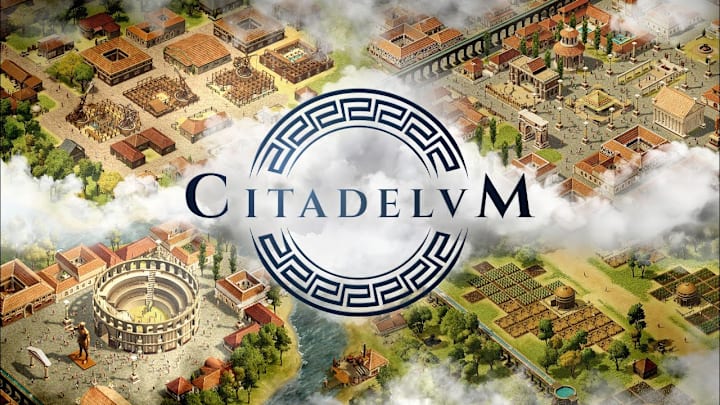Citadelum review: A tribute to the Pharaoh-style of city-builders

Remember Pharaoh? Remember Zeus? No, I’m not talking about your history classes – these are the titles of the isometric city-builders that Impressions Games and Sierra created around the turn of the millennium. I sunk many hours into these as a kid on my very first PC and so the gameplay of Abylight’s Citadelum caused quite a rush of nostalgia for me.
Citadelum is clearly inspired by the classics from a quarter of a century ago in many ways. It’s certainly paying homage to them visually, though does so in a clean and detailed manner fitting for our times. You can even zoom in and look into each and every one of your buildings, looking at the lovingly created interiors or observing your craftsmen at work – and that’s the sort of nice upgrade you’d expect from a modern take on the discipline, inviting you to simply take a minute and admire what you’ve created.
Its gameplay is explained fairly easily: You build up a city consisting of a population with two classes, Plebeians and Patricians, whose needs you’ll need to meet. Providing food and an assortment of other amenities a good Roman citizen expects – access to water, public baths, entertainment, and so on – as well as decorating your town with gardens and statues to buff areas’ desirability rating, which will lead to houses getting upgraded. These upgraded domiciles will provide more space for more people, leading to higher tax income and more workforce, but require more complex foods and amenities in turn.
It’s the classic Pharaoh model, right down to area desirability having a role to play – and that’s just as much fun to engage with now as it was back then. Figuring out the best layouts for your city, making the boundaries of markets, fire fighting posts, and engineer huts match, getting the vital tax collector into the mix somehow, and leaving enough space for some pretty trees while doing all that is very satisfying.
Where Citadelum falters a little bit is simply the amount of available content, such as the number of resources and production chains. It feels like I can relatively easily gain access to all available goods on any map. Some products are only available via trade routes (trade itself is quite limited, though), but it feels relatively trivial to get most of the other stuff you need to build a flourishing city.
That also has to do with the deity system in the game. Again, this is a mechanic that veterans of Pharaoh and co. will be familiar with: You can erect temples for several different deities from the Roman pantheon and celebrate festivals in these to gain their favor. Once you’ve filled up a god’s favor gauge, you can call them down from the heavens, having them bestow gifts and bonuses to the people of your city. These are generally not only worth it – they’re borderline overpowered.
A little bit of grain and money sacrificed to Ceres will have her come down and fill up the stores of all of your farms to the brim with nature’s bounty. Apollo comes down and delivers food to the city’s houses directly. Mars is probably my favorite one to cheese the economy with: You simply need to put down some recruitment buildings, call upon the god of war, and he’ll produce legions of troops for you for free – you can completely skip the part of the game that has you produce weapons and armor, because Mars can conjure fully equipped soldiers out of thin air.
On the flipside, ignoring one or several of the gods causes them to be displeased and come down to wreck your stuff. If you give Jupiter the cold shoulder, he’ll summon his lightning and thunder to demolish some buildings, for example. While this puts pressure on the player along with the threat of raids, it’s another factor leading to every map and every city feeling samey – you can’t really specialize cities on anything in this game, because you’re getting punished for it.
That brings us to the final part of the game, the combat. Citadelum features a strategic map layer. You can send out explorers to lift the fog of war from its territories, discovering potential trade partners, enemies, and even artifacts you can dedicate to the gods, boosting your favor with them.
You can also deploy the troops you build in your city into legions on this map, marching against enemies and challenging them to field battles. These battles will have you form up your units in the Total War style, but then the AI takes command, resolving the skirmish by itself in auto-battle format. You can be a bit tactical here thanks to the rock-paper-scissors relationship between infantry, cavalry, and archers, but it’s not exactly a deep or very engaging way of doing combat.
This entire system feels a little tagged on and a part of me wishes Abylight had focused more on economic content than this, but at the same time I totally get why the combat mechanics exist – this is a game about Rome, one of the most militaristic societies in world history. It feels like any game about Rome without some military systems is missing something crucial of what it tries to display. In essence, Abylight added this for the same reason Ubisoft Mainz wants to bring deeper combat mechanics to its upcoming Anno game set in Rome.
Abylight does provide a robust map editor to its community, allowing players to create their own challenges and scenarios from the ground up – this might be the answer to some of the game’s issues in the long term, but doesn’t exactly help at launch.
Citadelum successfully channels the spirit and charm of classic genre entries like Pharaoh and Zeus, bringing this iconic style of city-builder to the modern era, but lacks the variety and content to remain engaging for long. Abylight’s take on this style of game is excellent for those seeking a rush of nostalgia, but merely solid for everyone else.
Score: 7/10
Platform tested: PC
